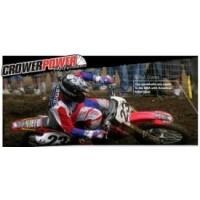QuadSponsor.com
Company History
Bruce Crower debuted his Cams, Fuel Systems and Clutches on the race cars of 'Big Daddy' Don Garlits and in fact was inducted into the Drag Racing Hall of Fame in 1993. Following in his father's footsteps, Dan Crower began producing camshafts and other valve train components for Indy cars.
In 1996, Dan went to the Indy 500 and caught the bug working with teams and making special cams for various customers in the Indy Racing league such as Tony Stewart, Sam Schmidt and 1998 winner Eddie Cheever; who also used Dan's custom-made cams when he won.
That same year, Dan turned his focus to the motorcycle industry, when the Yamaha 426 came out with the 5-valve head configuration. Dan had grown up on motorcycles and raced at Barona Oaks Motocross park in San Diego Ca as an youngster, so when the 426 was released it sparked his interest and he began testing parts on his new bike the day he bought it.
Today, Crower power has become one of the industry leaders manufacturing after-market valve train components for dirt bikes, ATV, road race and Harley motorcycles.
From Cams to Rods, race heads and engine kits, Crowers' components are available for the serious racer that wants that extra boost from their engines in order to gain a competitive edge.
What is a Camshaft?
Camshafts are the brain of your engine – its job is to open and close the valves at the precise moment to let fuel and air in and then let spent gasses out after combustion happens. With a greater lift and duration on the cam the engine can ingest more air and fuel to make its efficiency go up on every power stroke the piston makes. (Definitions found on answers.com)
What is Valve train?
Motorcycle engines work the same way that car engines do. They consist of a piston, a cylinder block and a head, which contains the valve train. The piston moves up and down in the cylinder block, driven by explosions of a fuel-air mixture that has been ignited by a spark. The camshaft allows the valves to open and close to allow the fuel-air mixture to enter the combustion chamber. As the piston moves up and down, it turns a crankshaft, which transforms the energy from the pistons into rotary motion. The rotational force of the crankshaft is transmitted, via the transmission to the rear wheel of the motorcycle. The four strokes refer to intake, compression, combustion and exhaust strokes that occur during two crankshaft rotations per working cycle of Otto cycle and Diesel engines. Its power cycle consists of adiabatic compression, heat addition at constant volume, adiabatic expansion and rejection of heat at constant volume and characterized by four strokes, or reciprocating movements of a piston in a cylinder: 1. Intake Stroke, 2. Compression Stroke, 3. Power stroke, 4. Exhaust stroke. The cycle begins at top dead center (TDC), when the piston is furthest away from the crankshaft. On the first stroke (intake) of the piston, a mixture of fuel and air is drawn into the cylinder through the intake (inlet) port. The intake (inlet) valve (or valves) then close(s) and the following stroke (compression) compresses the fuel-air mixture.
Four-stroke cycle (or Otto cycle)- The air-fuel mixture is then ignited, usually by a spark for a gasoline or Otto cycle engine or by the heat and pressure of compression for a Diesel cycle or compression ignition engine, at approximately the top of the compression stroke. The resulting expansion of burning gases pushes the piston downward for the third stroke (power) and in the fourth stroke (exhaust) the piston pushes the products of combustion from the cylinder through an exhaust valve or valves.
Valve Train-The valves are typically operated by a camshaft, with a series of cams along its length, each designed to open a valve appropriately for the execution of intake or exhaust strokes while rotating at half crankshaft speed. A tappet between valve and cam furnishes a contact surface on which the cam slides to open the valve. The location of the camshaft varies, as does the quantity. Most engines use overhead cams or even dual overhead cams as in the illustration, in which cams directly actuate valves through a flat tappet. This design is typically capable of higher engine speeds because it gives the most direct and shortest inelastic path between cam and valve. In other engine designs, the cam shaft is placed in the crankcase and its motion transmitted by a push rod, rocker arms, and valve stems.
